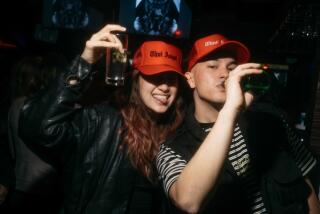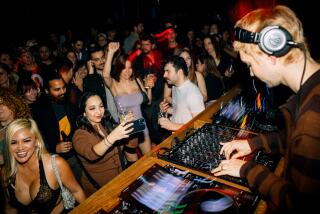Underground music hero Delroy Edwards fosters an above-board approach
Delroy Edwards knew he’d never play a glitzy Hollywood nightclub again.
In April, the 24-year -old producer was DJ’ing at Avalon, one of the city’s premier EDM clubs. His sound — a noisy, melancholic take on classic techno — was coming in vogue. The show was one of the largest he’d ever played in his hometown.
Edwards, a biracial son of Jamaican and white parents, was dressed in his usual uniform of an oversized T-shirt and drapey mesh shorts, as were the small group of friends there to see him play. When they walked backstage to the artist area, they found a crew of Hollywood hangers-on getting drunk in the VIP section.
LISTEN: Music from producer Delroy Edwards
“One them looked at us and said, ‘Damn, looks like the basketball team is here,’” Edwards recounted, shaking his head in disbelief. He was the star performer that night. But the guy’s drunk, racist quip still stung him. “I was like, ‘What decade is this?’”
The rest of the show was fine. But that night, Edwards and his friends retreated from the neon lights and big paychecks of Hollywood for good. They were already building a new home for their sound.
With his year-old label, L.A. Club Resource, Edwards has created an aesthetic unlike anything else in Los Angeles nightlife today. With fewer than a dozen 12-inch vinyl singles (some from himself, some from other artists, most of which promptly sell out of their 500-to-1,500-copy pressings), he’s honed a club-music style stripped of any sheen and triumph. His tracks reveal the lonely, vacant feelings that drive people to party in lost spaces on the fringe of L.A.
With longtime record-business friends Henoch Moore and Jimmy Mock, he’s also teamed on a complementary project. Their indie distribution firm, label and online store, Gene’s Liquor, resurrects long-lost albums of New Orleans rap and sex-ravaged funk. They’re channeling the energy around LACR’s singles (a buzz that larger dance labels spend fortunes trying to manufacture) into reissues of ultra-obscure, regional party records, mastered in-house from dusty cassette tapes sourced from the backs of the rappers’ closets.
If clubs are about escaping the real world, then Gene’s Liquor and L.A. Club Resource are the city’s most vivid late-night fever dream.
On a Wednesday afternoon in October, Edwards, Moore and Mock rolled up in Mock’s dusty black Toyota 4Runner, the air pungent with smoke at 1 p.m. They were meeting for lunch at Natraliart, a Jamaican restaurant in Arlington Heights far from the typical dragstrips of L.A. nightlife. Mock (whose name, like Edwards’, is an alias he uses for this project) and Moore, each 26, share an apartment and office just a few blocks away. Edwards, who recently decamped from the neighborhood to Mount Washington, has eaten here since he was a kid growing up in Silver Lake.
This stretch of Mid City — working class, unshowy, near many L.A. subcultures without belonging to any of them — makes sense for their operation. Edwards said he’d been roughed up by cops and locals while walking around the block a few times, but generally they have the space to do whatever they want here.
“One time we did a party at (the venue) Underground Museum next to this Latino church down the street. We always have a good sound system and we were worried about the cops and neighbors, but lucky for us, the church was blasting music harder than we were,” Moore said.
Although L.A. is a major hub for the current wave of mainstream EDM, the city is finding its bearings as an international city for underground club music. For inventive new L.A. labels like LACR, Body High or Fade to Mind, that’s the city’s biggest challenge but perhaps its best potential.
“I’m acutely aware of how isolated the West Coast’s major cities are from New York, London and Europe,” said Philip Sherburne, the Portland-raised and Barcelona-based DJ and dance music critic for Pitchfork and Spin magazine. “The dominance of a commercial dance-music scene will make those artists and fans who want something different work a little bit harder to create a viable alternative, and that seems to be happening in L.A.”
That sense of distance and isolation drives LACR’s aesthetic. All its releases have a near-identical black-and-white layout with grainy photos of crime scenes, car crashes and horror movies. Edwards announced the label in fall 2013 with a tape-decayed YouTube clip listing a phone number that, when called, just loops on endless ringtone. The Gene’s Liquor site uses a gothic-English script from bootlegged gangsta rap T-shirts, and the crew admits their tastes can be alienating. One LACR release is a three minutes of a churning drone that Edwards admits he wrote “as a DJ tool to just scare the (heck) out of people in the club.”
But there’s heart there too. Edwards honed his sound after moving to New York in 2010, where he met Ron Morelli of the influential techno label L.I.E.S., which released Edwards’ first few singles before he returned to L.A. to found his own imprint. The tastemaking magazine Fader named L.A. Club Resource one of the best new labels of 2014, describing its sound as “textural house music emanating from lonely bedroom studios.”
Edwards’ dazed, distorted tracks come from a techno tradition “shot through with melancholy, or at least unease,” Sherburne said. “Despite [their] obvious party vibes,” Edwards and his LACR releases “frequently sound nervous and slightly unstrung.”
But out on the dance floor, his songs still feel musical and emotional. “Honestly, when we’re home we never listen to club music,” Edwards said. “We just listen to old soul records like the Isley Brothers.”
Edwards’ striking looks (he’s 6-foot-5 with full sleeves of tattoos) and skillful antagonism behind the turntables turned him into a underground hero but a difficult one. Conventional wisdom declares that online streaming services are the future for music (and if it doesn’t pay the rent for new artists, then that’s too bad). Gene’s Liquor and LACR are making a case for party music that’s weird, scarce and tangible.
“Even their tapes sell well here, which is really rare for electronic music,” said Burgess Tomlinson, a manager for the electronic music department at Amoeba Music in Hollywood. “Their limited runs are a good strategy; kids know it’s going to run out so they have to get it now. Even non-DJ’s are saying ‘I want this on record.’”
Edwards is low-key and funny in person (and encyclopedic about his musical interests). But he shuns almost anything that feels like a spotlight. He’s suspicious about the current club-music scene’s commercial motivations. Even ostensible allies, like Berlin’s internationally renowned underground venue Berghain, seemed to let him down.
“You’re going to tell me, at a club I’m playing, that you’re turning away my friends because of how they look? Because they’re not hipsters wearing leather bondage gear? This is supposed to be music for outsiders,” Edwards said, in a rain of profanity about Berghain’s strict door and dress policies. “There are reasons we’re so closed off.”
If Edwards tries to stay in the shadows as an artist, then Gene’s Liquor is the more public face of the trio’s musical world.
Moore and Mock had each worked at various L.A. indie companies, like the punk label Sargent House, the psychedelic funk label Now-Again and managing for the hip-hop producer Madlib. But they could never find an outlet that squared all of their interests — futuristic techno, needling noise music, forgotten Southern rap. They knew there was a market for this trippy, sad party music (they’d seen Japanese kids re-selling rare rap tapes for hundreds of dollars on eBay). Now they’re trying to make a small but sustainable living from it.
Gene’s Liquor (named for a favored San Francisco store) distributes all of LACR’s releases and their own catalog, where tracks from Edwards and contemporary producers such as Delivery and Skander sit alongside reissues from Chicago house hero Gene Hunt and a long-lost demo from the ‘90s Memphis rapper Shawty Pimp.
Combing through their online stock of vintage recordings is like stumbling on a fantasy bodega dollar-tape bin. There are VHS documentaries on the Houston producer DJ Screw, deep-catalog mixes from New Orleans rap labels No Limit and Mobo, and vinyl singles from the pioneering Chicago label Dance Mania. It’s not hugely profitable yet, but other club-music labels, like Germany’s Kompakt Records, stay solvent by distributing both their own releases and smaller labels’ catalogs. Gene’s Liquor does something similar but tuned to their own unusual tastes.
“Sometimes working with these artists is a bit of challenge,” Mock said. “The guys we work with come from a bunch of different places, so different things come up. Sometimes the only master left is a cassette tape, so we gotta master the tracks from that.”
Contrary to their label’s vibe, which suggests a crew of stoned after-hours vampires, the members really are fundamentally sweet and earnest music fans. “We all moved out of our apartments and gave up everything to do this, because we all have issues with the [music-business] system as it stands.” Mock said. Moore agreed: “We wanted to create an infrastructure where we can be completely independent. Once we make that, it’ll always be there. I’m hoping to start a family on this one day.”
As they rolled blunts and tossed a football around Moore and Mock’s driveway, the harsh afternoon sun beat down in their eyes. Gangsta rap spilled out of a neighboring window, and few dogs trotted by an adjoining spiked metal fence.
They were home, at last.
More to Read
The biggest entertainment stories
Get our big stories about Hollywood, film, television, music, arts, culture and more right in your inbox as soon as they publish.
You may occasionally receive promotional content from the Los Angeles Times.







